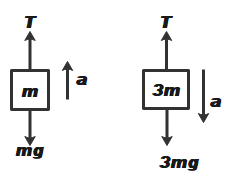
If the system is released, then the acceleration of the centre of mass of the system is

A. \[\dfrac{g}{4}\]
B. \[\dfrac{g}{2}\]
C. \[g\]
D. \[2g\]

Answer
562.8k+ views
Hint: In this question we have been asked to calculate the acceleration of centre of mass of the given pulley system. To solve this question, we shall first calculate the acceleration of the two blocks by using the equation of motion from the free body diagram. Later, using this result we shall calculate the acceleration of the centre of mass of the given system. Centre of mass is a point in space at which the whole mass of the system can be assumed to be concentrated.
Formula Used: \[{{a}_{c}}=\dfrac{{{m}_{1}}{{a}_{1}}-{{m}_{2}}{{a}_{2}}}{{{m}_{1}}+{{m}_{2}}}\]
Where,
\[{{a}_{c}}\] is the acceleration of centre of mass
\[{{m}_{1}}\] and \[{{m}_{2}}\] is the mass of the two blocks
\[{{a}_{1}}\] and \[{{a}_{2}}\] is the acceleration of blocks
Complete answer:
The FBD for the given pulley mass system will be as shown in the figure, below.

Therefore, from the above figure we can write,
\[T-mg=ma\] ……………… (1)
Similarly,
\[3mg-T=3ma\] …………….. (2)
Therefore, from (1) and (2)
We get,
\[2mg=4ma\]
Let us assume,
\[g=10\] ……………. (A)
Therefore,
\[a=5m/{{s}^{2}}\]
Now we know that, acceleration of centre of mass of system is given by,
\[{{a}_{c}}=\dfrac{{{m}_{1}}{{a}_{1}}-{{m}_{2}}{{a}_{2}}}{{{m}_{1}}+{{m}_{2}}}\]
Where,
\[{{a}_{1}}={{a}_{2}}=5\]
After substituting the values,
We get,
\[{{a}_{c}}=\dfrac{5\left( 3m-m \right)}{m+3m}\]
Therefore,
\[{{a}_{c}}=\dfrac{10}{4}\]
Now from (A) we can say that,
\[{{a}_{c}}=\dfrac{g}{4}\]
Therefore, the correct answer is option A.
Note:
The centre of mass can be calculated by taking the masses and multiplying them by their positions from the selected point of origin and dividing them by the total mass of the system. The centre of mass is a point on which the force is applied; it causes linear acceleration without an angular acceleration. The concept of centre of mass was introduced by Archimedes.
Formula Used: \[{{a}_{c}}=\dfrac{{{m}_{1}}{{a}_{1}}-{{m}_{2}}{{a}_{2}}}{{{m}_{1}}+{{m}_{2}}}\]
Where,
\[{{a}_{c}}\] is the acceleration of centre of mass
\[{{m}_{1}}\] and \[{{m}_{2}}\] is the mass of the two blocks
\[{{a}_{1}}\] and \[{{a}_{2}}\] is the acceleration of blocks
Complete answer:
The FBD for the given pulley mass system will be as shown in the figure, below.

Therefore, from the above figure we can write,
\[T-mg=ma\] ……………… (1)
Similarly,
\[3mg-T=3ma\] …………….. (2)
Therefore, from (1) and (2)
We get,
\[2mg=4ma\]
Let us assume,
\[g=10\] ……………. (A)
Therefore,
\[a=5m/{{s}^{2}}\]
Now we know that, acceleration of centre of mass of system is given by,
\[{{a}_{c}}=\dfrac{{{m}_{1}}{{a}_{1}}-{{m}_{2}}{{a}_{2}}}{{{m}_{1}}+{{m}_{2}}}\]
Where,
\[{{a}_{1}}={{a}_{2}}=5\]
After substituting the values,
We get,
\[{{a}_{c}}=\dfrac{5\left( 3m-m \right)}{m+3m}\]
Therefore,
\[{{a}_{c}}=\dfrac{10}{4}\]
Now from (A) we can say that,
\[{{a}_{c}}=\dfrac{g}{4}\]
Therefore, the correct answer is option A.
Note:
The centre of mass can be calculated by taking the masses and multiplying them by their positions from the selected point of origin and dividing them by the total mass of the system. The centre of mass is a point on which the force is applied; it causes linear acceleration without an angular acceleration. The concept of centre of mass was introduced by Archimedes.
Recently Updated Pages
Why are manures considered better than fertilizers class 11 biology CBSE

Find the coordinates of the midpoint of the line segment class 11 maths CBSE

Distinguish between static friction limiting friction class 11 physics CBSE

The Chairman of the constituent Assembly was A Jawaharlal class 11 social science CBSE

The first National Commission on Labour NCL submitted class 11 social science CBSE

Number of all subshell of n + l 7 is A 4 B 5 C 6 D class 11 chemistry CBSE

Trending doubts
What is meant by exothermic and endothermic reactions class 11 chemistry CBSE

10 examples of friction in our daily life

One Metric ton is equal to kg A 10000 B 1000 C 100 class 11 physics CBSE

1 Quintal is equal to a 110 kg b 10 kg c 100kg d 1000 class 11 physics CBSE

Difference Between Prokaryotic Cells and Eukaryotic Cells

What are Quantum numbers Explain the quantum number class 11 chemistry CBSE




